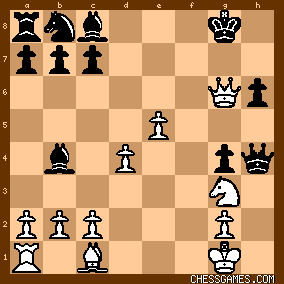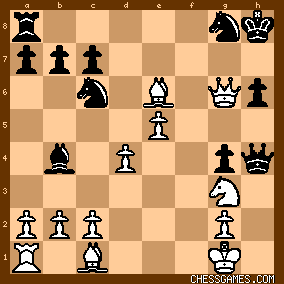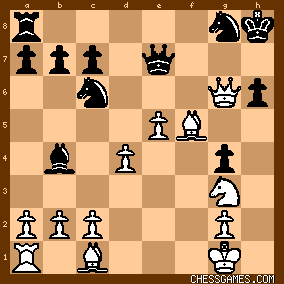|
< Earlier Kibitzing · PAGE 3 OF 3 ·
Later Kibitzing> |
| Jul-29-16 | | Patriot: 16.Rxf3 gxf3 17.Qxf3 but I missed the defense, 17...Nf6. 17...Qe7 18.Nh5+ ends matters quickly. I probably threw out 17...Nf6 because it just "drops a piece" but that's not a valid reason to reject it when white sacs a rook first! The rook sac made sense to not only stop blacks threat of Qxg3 but to re-capture with the queen and stir up mate threats. So 17...Nf6 is perfectly logical. I think the real difficulty begins on this move (17...Nf6), and after 18.exf6+ Kf8 (18...Qxf6 19.Nh5+  ) 19.Bf4! (not easy to find) Qxf6?? 20.Be6+ Kg7 21.Nh5+ ) 19.Bf4! (not easy to find) Qxf6?? 20.Be6+ Kg7 21.Nh5+  . 20.Qe4 threatens a simple discovered check, winning the queen, and the threats just keep going. . 20.Qe4 threatens a simple discovered check, winning the queen, and the threats just keep going. |
|
| Jul-29-16 | | Patriot: <agb2002> <White is a knight down> I never noticed this. But when you count active pieces it's not that way! Still it is important to know what the bar is before beginning to analyze, even though most of the time in these problems one can analyze correctly even without a material count. |
|
| Jul-29-16 | | kevin86: The attack is even worth a rook sacrificed. |
|
Jul-29-16
 | | Jimfromprovidence: I am having a problem figuring out the response to 16...Rh7?!
click for larger view |
|
Jul-29-16
 | | tpstar: <Jimfromprovidence> Try chopping wood with 17. Rf7+ Kh8 (17 ... Kg6 18. Qd3+ Bf5 19. Qxf5#) 18. Rxh7+ Kxh7 19. Qd3+ Kg7/Kh8 20. Bxg8 Kxg8 21. Qg6+:
click for larger view1) 21 ... Kf8 22. Bxh6+ Ke7 23. Bg5+ wins the Queen.
2) 21 ... Kh8 22. Bxh6 Qe7 (covering g7) 23. Bg5 & 24. Bf6/+ wins the Queen. |
|
Jul-29-16
 | | Jimfromprovidence: <tpstar> <Try chopping wood with 17. Rf7+ Kh8 (17 ... Kg6 18. Qd3+ Bf5 19. Qxf5#) 18. Rxh7+ Kxh7 19. Qd3+ Kg7/Kh8 20. Bxg8 Kxg8 21. Qg6+:> Thanks, mucho.
I had it slightly differently; 17 Rf7+ Kh8 18 Rxh7+ Kxh7 19 Qd3+ Kh8, then 20 Qg6. 
click for larger view
I got stuck after 20...Be6 Bxe6 21 Nc6.

click for larger viewI could not determine if white could move his knight safely because of the queen check on e1. |
|
Jul-29-16
 | | olinart: In the game played, 20 ..Qxf6 21.Be5 Qe7 22.Rf1+ Ke8
gets black out of the attack at the cost of a pawn. Nevertheless the rook sac got white out of serious trouble. |
|
| Jul-29-16 | | patzer2: <grootbrabrandt> Yes by "the second player" I mean Black. See https://en.wikipedia.org/wiki/Gloss.... |
|
| Jul-29-16 | | ruzon: <Jimfromprovidence> In your diagram, 22. Bf5 seals the deal. 22...Nf6 postpones mate by one move. |
|
| Jul-29-16 | | agb2002: <Patriot: <agb2002> <White is a knight down> I never noticed this. But when you count active pieces it's not that way! Still it is important to know what the bar is before beginning to analyze, even though most of the time in these problems one can analyze correctly even without a material count.> The material count is the very first task I consider in any position, even it's just a forced mate in two, for a number of reasons (if you don't like them I have others): -It's a matter of habit, or discipline if you like, and also the typical chess manual first step in the evaluation of a position (mainly dynamic or mainly static). -For most puzzles, it is rarely a mate in two, with the exception of Mondays which are normally only Chess 101. -One may discover an 'elegant' combination resulting in a gain of, say, two pawns but then it turns out that one only has two pawns for a piece. -The result of an attack combination might be material advantage or a better ending in which every pawn and piece counts. -For example, one may have an exchange deficit due to a previous attacking combination and have the possibility of keeping the attack alive or reach an endgame such that the bishop pair is stronger than a rook and a knight. -The material count and the interactions amongst pieces give an idea of what pieces should be kept and what could be traded or even sacrificed. -It is a simple method to slow down somewhat if one has a marked tendency to rush with the 'solution' and I'm in a rush now because my family is waiting for me to have dinner... |
|
| Jul-29-16 | | Patriot: <agb2002> (Patriot clicks the "Like" button) |
|
| Jul-29-16 | | dehanne: I knew the game as a former King's Gambit player. |
|
| Jul-29-16 | | Patriot: <agb2002>
<-One may discover an 'elegant' combination resulting in a gain of, say, two pawns but then it turns out that one only has two pawns for a piece.> This is true especially OTB. For puzzle problems where it is known there is a winning combination, usually the "maximum effect" of material or mate is correct no matter what the material count is. But I think it is more important to practice as one plays because when you play you want that kind of thinking to be automatic. One could also say that OTB there shouldn't be a need to take stock in material because you should know the material difference at all times, so jumping into "solving" a puzzle isn't necessarily out of line with that process--it's usually safe to assume the elegant combination is correct! |
|
| Jul-29-16 | | drollere: i had 16. Bf4 followed by Qd3, c3 etc.
the sacrifice is cute, but i don't see reason to rush things. the annoying Q aside black does not have a convincing attack with 2 p's, the white K is well defended by several pieces, and the black K is out in the open. the black Q sacrifice, if not a blunder, seems panicky. |
|
Jul-29-16
 | | Jimfromprovidence: <ruzon> <In your diagram, 22. Bf5 seals the deal. 22...Nf6 postpones mate by one move.> I'm not sure about the mate part because after 22 Bf5 black has 22...Qe7, below. You did answer my question, so thanks for that, since white does not have to worry about queen checks after 22...Qe7 to win. He can follow with 23 Bxh6 with multiple threats, as an example. 
click for larger view |
|
| Jul-29-16 | | DarthStapler: I got the first two moves |
|
| Jul-29-16 | | King.Arthur.Brazil: I follow the game, after my proposal, and the moves I do wrong were: 19.Bf4!... I tried Qe3. 20.Qe4!... I went on Be5? 22.Bh6+!, I did Bd6+, with same idea (now) but this is not the better move anyway, I did wrong. Again I didn't find 20.c3, but played 20.Nf5 directly that is not so good this time. I did right the two checks and Nh6, but I was expecting some answer to continue the game, but Black resignes and I feel sorry, cause I begin to enjoy the game... lgs. |
|
Nov-10-21
 | | DanQuigley: This is Game 21 in my edition of Richtig Opfern (The Art of the Sacrifice). Spielmann's game heading indicates he played it in June, 1903 in the Munich Chess Club tournament. That's possible, I suppose, but I can find no record of such a tournament as having taken place. I think it likelier the game was from the Munich 1904 tournament that took place in November 1904, of which there is a public record of both these players participating. I am not sure why Englishman in his 7/29/16 post states that Spielmann did not know the theory. I think it likely he did. Spielmann indicates in his notes to the game that 9...Nf6 10.Nc3 Bb4 was considered the normal course at that time, but that the text move (9...Qf6) had been analyzed in the chess club in Charkov. Who knows how much of that analysis Spielmann followed before striking out on his own? |
|
May-19-25
 | | MissScarlett: <I can find no record of such a tournament as having taken place. I think it likelier the game was from the Munich 1904 tournament that took place in November 1904, of which there is a public record of both these players participating.> This game appears in van Vliet's column in <To-Day> of August 12th 1903, where it's stated to be <recently produced in the Summer Tournament of the Munich Chess Club>. The players are given as <H. Spielmann> and <G. E.>. |
|
May-19-25
 | | Sally Simpson: Just confirming this game is 'Example 21' (sic) with the same info as on this thread's game in his 'Art of Sacrifice' (1935) 'From a club tournament, Munich, June 1903." The Algebraic version (2015) just has, Munich 1903.
The (2015) book is expanded with extra games from Tal, Shirov, Topalov etc to show how Spielmann's ideas have been taken further. Good. Also very good is the puzzles section.
In the solution you get the full game that leads you to the puzzle position. Wonderful, saves me looking for the game and seeing how the critical position got set up.
Possibly a nod to Spielmann who said he too could play all of Alekhine's combo's but if he could only set them up. (paraphrased) |
|
| May-19-25 | | stone free or die: Can we recheck the June date for this game?
Looking at the 1995 Dover reprint, which claims to be an unaltered but abridged version of the David McKay 1951 version, just gives <Munich, 1903> with Black identified as <M. Eljaschoff> (Ex 21, p95). I found mention of a 1903 Munich club tournament, won by Spielmann, in a Munich newspaper, published in very close proximity to <Missy>'s find. <In the Munich Chess Club's summer tournament, which was contested by seven participants, the prizes were won by... 1. Spielmann, 2.Busch, 3.Gregory
The winner is a 20-year-old chess talent, who will surely make a name for himself on the 64 squares. > <Münchner neueste Nachrichten 1903-08-09 p5> |
|
May-19-25
 | | Sally Simpson: My 1935 Bell's Edition, says; ''From a club tournament, Munich, June 1903." (on page 103). |
|
| May-19-25 | | Alan McGowan: The game is in the October 1903 Deutsche Schachzeitung, p311. The heading says: Gespielt am 9. Juni 1903 in Sommerturnier des Münchener Schachklubs. The September 1903 DSZ, p288, has a brief report of the results: I Rudolf Spielmann nach einem Stichkampf gegen II Eugen Busch, III B. Gregory. |
|
| May-19-25 | | stone free or die: Thanks <Sally>, for double-checking (you did say it before, but it's nice to know who the publisher was). And thanks <Alan> for getting the DSZ source - it's readily available via Google books and has the precise date: https://books.google.com/books?id=j... |
|
May-20-25
 | | Sally Simpson: A Club Tournament usually differs from a normal tournament. It can take place over weeks and even months as you play each round on a club night. It appears this is what happened. The August report is of a tournament that started in June but possibly finished late July. |
|
 |
 |
|
< Earlier Kibitzing · PAGE 3 OF 3 ·
Later Kibitzing> |





